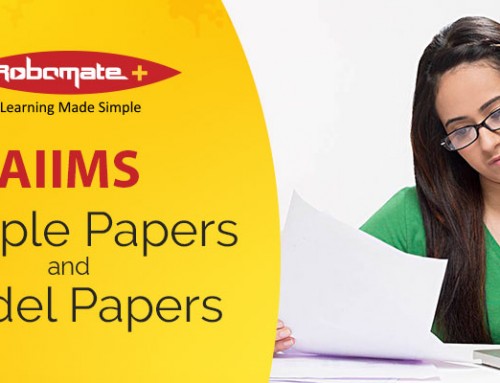AIIMS Syllabus will cover questions from Physics, Chemistry, Biology and General Knowledge.
AIIMS MBBS 2018 Physics Syllabus
UNIT I: Electrostatics
Electric charges and their conservation. Coulomb’s law-force between two point charges, forces between multiple charges; superposition principle and continuous charge distribution.
Electric field, electric field due to a point charge, electric field lines; electric dipole, electric field due to a dipole; torque on a dipole in a uniform electric field.
Electric flux, statement of Gauss’s theorem and its applications to find field due to infinitely long straight wire, uniformly charged infinite plane sheet and uniformly charged thin spherical shell (field inside and outside)
Electric potential, potential difference, electric potential due to a point charge, a dipole and system of charges: equipotential surfaces, electrical potential energy of a system of two point charges and of electric diploes in an electrostatic field.
Conductors and insulators, free charges and bound charges inside a conductor. Dielectrics and electric polarization, capacitors and capacitance, combination of capacitors in series and in parallel, capacitance of a parallel plate capacitor with and without dielectric medium between the plates, energy stored in a capacitor, Van de Graaff generator.
UNIT II: Current Electricity
Electric current, flow of electric charges in a metallic conductor, drift velocity and mobility, and their relation with electric current; Ohm’s law, electrical resistance, V-I characteristics (linear and non-linear), electrical energy and power, electrical resistivity and conductivity.
Carbon resistors, colour code for carbon resistors; series and parallel combinations of resistors; temperature dependence of resistance.
Internal resistance of a cell, potential difference and emf of a cell, combination of cells in series and in parallel.
Kirchhoff’s laws and simple applications. Wheatstone bridge, Meter Bridge.
Potentiometer-principle and applications to measure potential difference, and for comparing emf of two cells; measurement of internal resistance of a cell.
UNIT III: Magnetic Effects of Current and Magnetism
Concept of magnetic field, Oersted’s experiment. Biot-Savart law and its application to current carrying circular loop.
Ampere’s law and its applications to infinitely long straight wire, straight and toroidal solenoids. Force on a moving charge in uniform magnetic and electric fields. Cyclotron.
Force on a current-carrying conductor in a uniform magnetic field. Force between two parallel current-carrying conductors-definition of ampere. Torque experienced by a current loop in a magnetic field; moving coil galvanometer-its current sensitivity and conversion to ammeter and voltmeter.
Current loop as a magnetic dipole and its magnetic dipole moment. Magnetic dipole moment of a revolving electron. Magnetic field intensity due to a magnetic dipole (bar magnet) along its axis and perpendicular to its axis. Torque on a magnetic dipole (bar magnet) in a uniform magnetic field; bar magnet as an equivalent solenoid, magnetic field lines; Earth’s magnetic field and magnetic elements.
Para-, dia-and Ferro-magnetic substances, with examples.
Electromagnetic and factors affecting their strengths. Permanent magnets.
UNIT IV: Electromagnetic Induction and Alternating Currents
Electromagnetic induction; Faraday’s law, induced emf and current; Lenz’s Law, Eddy currents. Self and mutual inductance.
Alternating currents, peak and rms value of alternating current/ voltage; reactance and impedance; LC oscillations (qualitative treatment only), LCR series circuit, resonance; power in AC circuits, wattless current.
AC generator and transformer.
UNIT V: Electromagnetic Waves
Need for displacement current.
Electromagnetic waves and their characteristics (qualitative ideas only). Transverse nature of electromagnetic waves.
Electromagnetic spectrum (radio waves, microwaves, infrared, visible, ultraviolet, x-rays, gamma rays) including elementary facts about their uses.
UNIT VI: Optics
Reflection of light, spherical mirrors, mirror formula. Refraction of light, total internal reflection and its applications optical fibres, refraction at spherical surfaces, lenses, thin lens formula, lens-maker’s formula. Magnification, power of a lens, combination of thin lenses in contact combination of a lens and a mirror. Refraction and dispersion of light through a prism.
Scattering of light- blue colour of the sky and reddish appearance of the sun at sunrise and sunset.
Optical instruments: Human eye, image formation and accommodation, correction of eye defects (myopia and hypermetropia) using lenses.
Microscopes and astronomical telescopes (reflecting and refracting) and their magnifying powers.
Wave optics: Wavefront and Huygens’ Principle, reflection and refraction of plane wave at a plane surface using wave fronts.
Proof of laws of reflection and refraction using Huygens’ Principle.
Interference, Young’s double hole experiment and expression for fringe width, coherent sources and sustained interference of light.
Diffraction due to a single slit, width of central maximum.
Resolving power of microscopes and astronomical telescopes. Polarization, plane polarized light; Brewster’s law, uses of plane polarized light and Polaroids.
UNIT VII: Dual Nature of Matter and Radiation
Photoelectric effect, Hertz and Lenard’s observations; Einstein’s photoelectric equation- particle nature of light.
Matter waves-wave nature of particles, de Broglie relation. Davisson-Germer experiment (experimental details should be omitted; only conclusion should be explained).
NIT VIII: Atoms and Nuclei
Alpha- particle scattering experiments; Rutherford’s model of atom; Bohr model, energy levels, hydrogen spectrum. Composition and size of nucleus, atomic masses, isotopes, isobars; isotones.
Radioactivity-alpha, beta and gamma particles/ rays and their properties decay law. Mass-energy relation, mass defect; binding energy per nucleon and its variation with mass number, nuclear fission and fusion.
UNIT IX: Electronic Devices
Energy bands in solids (qualitative ideas only), conductors, insulators and semiconductors; semiconductor diode- I-V characteristics in forward and reverse bias, diode as a rectifier; I-V characteristics of LED, photodiode, solar cell, and Zener diode; Zener diode as a voltage regulator. Junction transistor, transistor action, characteristics of a transistor; transistor as an amplifier (common emitter configuration) and oscillator. Logic gates (OR, AND, NOT, NAND and NOR). Transistor as a switch.
AIIMS MBBS 2018 Chemistry Syllabus
UNIT I: Solid State
Classification of solids based on different binding forces; molecular, ionic covalent and metallic solids, amorphous and crystalline solids (elementary idea), unit cell in two dimensional and three dimensional lattices, calculation of density of unit cell, packing in solids, packing efficiency, voids, number of atoms per unit cell in a cubic unit cell, point defects, electrical and magnetic properties, Band theory of metals, conductors, semiconductors and insulators.
UNIT II: Solutions
Types of solutions, expression of concentration of solutions of solids in liquids, solubility of gases in liquids, solid solutions, colligative properties- relative lowering of vapour pressure, Raoult’s law, elevation of boiling point, depression of freezing point, osmotic pressure, determination of molecular masses using colligative properties abnormal molecular mass. Van Hoff factor.
UNIT III: Electrochemistry
Redox reactions, conductance in electrolytic solutions, specific and molar conductivity variation of conductivity with concentration, kohlrausch’s Law, electrolysis and Laws of electrolysis (elementary idea), dry cell- electrolytic cells and Galvanic cells; lead accumulator, EMF of a cell, standard electrode potential, Relation between Gibbs energy change and EMF of a cell, fuel cells; corrosion.
UNIT IV: Chemical Kinetics
Rate of a reaction (average and instantaneous), factors affecting rates of reaction; concentration, temperature, catalyst; order and molecularity of a reaction; rate law and specific rate constant, integrated rate equations and half-life (only for zero and first order reactions); concept of collision theory ( elementary idea, no mathematical treatment). Activation energy, Arrhenious equation.
UNIT V: Surface Chemistry
Adsorption-physisorption and chemisorption; factors affecting adsorption of gases on solids, catalysis homogeneous and heterogeneous, activity and selectivity: enzyme catalysis; colloidal state: distinction between true solutions, colloids and suspensions; lyophillic, lyophobic multimolecular and macromolecular colloids; properties of colloids; Tyndall effect, Brownian movement, electrophoresis, coagulation; emulsions- types of emulsions.
UNIT VI: General Principles and Processes of Isolation of Elements
Principles and methods of extraction- concentration, oxidation, reduction electrolytic method and refining; occurrence and principles of extraction of aluminium, copper, zinc and iron.
UNIT VII: p- Block Elements
Group 15 elements: General introduction, electronic configuration, occurrence, oxidation states, trends in physical and chemical properties; preparation and properties of ammonia and nitric acid, oxides of nitrogen (structure only); Phosphorous- allotropic forms; compounds of phosphorous: preparation and properties of phosphine, halides (PCI3 , PCI5 ) and oxoacids (elementary idea only).
Group 16 elements: General introduction, electronic configuration, oxidation states, occurrence, trends in physical and chemical properties; dioxygen: preparation, properties and uses; classification of oxides; ozone. Sulphur – allotropic forms; compounds of sulphur: preparation, preparation, properties and uses of sulphur dioxide; sulphuric acid: industrial process of manufacture, properties and uses, oxoacids of sulphur (structures only).
Group 17 elements: General introduction, electronic configuration, oxidation states, occurrence, trends in physical and chemical properties; compounds of halogens: preparation, properties and uses of chlorine and hydrochloric acid, interhalogen compounds oxoacids of halogens (structures only).
Group 18 elements: General introduction, electronic configuration, occurrence, trends in physical and chemical properties, uses.
UNIT VIII: d and f Block Elements
General introduction, electronic configuration, characteristics of transition metals, general trends in properties of the first row transition metals- metallic character, ionization enthalpy, oxidation states, ionic radii, colour, catalytic property, magnetic properties, interstitial compounds, alloy formation. Preparation and properties of K2Cr2O7 and KMnO4.
Lanthanides- electronic configuration, oxidation states, chemical reactivity, and lanthanide contraction and its consequences.
Actinides- Electronic configuration, oxidation states and comparison with lanthanides.
UNIT IX: Coordination Compounds
Coordination compounds: Introduction, ligands, coordination number, colour, magnetic properties and shapes, IUPAC nomenclature of mononuclear coordination compounds, isomerism (structural and stereo) bonding, Werner’s theory VBT, CFT; importance of coordination compounds (in qualitative analysis, biological systems).
UNIT X: Haloalkanes and Haloarenes
Haloalkanes: Nomenclature, nature of C –X bond, physical and chemical properties, mechanism of substitution reactions. Optical rotation.
Haloarenes: Nature of C-X bond, substitution reactions (directive influence of halogen for monosubstituted compounds only).
Uses and environment effects of – dichloromethane, trichloromethane, tetra chloromethane, iodoform, freons, DDT.
UNIT XI: Alcohols, Phenols and Ethers
Alcohols: Nomenclature, methods of preparation, physical and chemical properties (of primary alcohols only); identification of primary, secondary and tertiary alcohols; mechanism of dehydration, uses with special reference to methanol and ethanol.
Phenols: Nomenclature, methods of preparation, physical and chemical properties, acidic nature of phenol, electrophilic substitution reactions, uses of phenols.
Ethers: Nomenclature, methods of preparation, physical and chemical properties uses.
UNIT XII: Aldehydes, Ketones and Carboxylic Acids
Aldehydes and Ketones: Nomenclature, nature of carbonyl group, methods of preparation, physical and chemical properties; and mechanism of nucleophilic addition, reactivity of alpha hydrogen in aldehydes; uses.
Carboxylic Acids: Nomenclature, acidic nature, methods of preparation, physical and chemical properties; uses.
UNIT XIII: Organic Compounds Containing Nitrogen
Amines: Nomenclature, classification, structure, methods of preparation, physical and chemical properties, uses, identification of primary secondary and tertiary amines.
Cyanides and Isocyanides: will be mentioned at relevant places.
Diazonium salts: Preparation, chemical reactions and importance in synthetic organic chemistry.
UNIT XIV: Biomolecules
Carbohydrates- Classification (aldoses and ketoses), monosaccharide (glucose and fructose), D.L. configuration, oligosaccharides (sucrose, lactose, and maltose), and polysaccharides (starch, cellulose, glycogen): importance.
Proteins- Elementary idea of – amino acids, peptide bond, polypeptides, proteins, primary structure, secondary structure, tertiary structure and quaternary structure (qualitative idea only), denaturation of proteins; enzymes.
Hormones- Elementary idea (excluding structure).
Vitamins- Classification and function.
Nucleic Acids: DNA and RNA
UNIT XV: Polymers
Classification- Natural and synthetic, methods of polymerization (addition and condensation), copolymerization. Some important polymers: natural and synthetic like polyesters, bakelite; rubber, Biodegradable and non-biodegradable polymers.
UNIT XVI: Chemistry in Everyday Life
Chemicals in medicines- analgesics, tranquilizers, antiseptics, disinfectants, antimicrobials, antifertility drugs, antibiotics, antacids, antihistamines.
Chemicals in food- preservatives, artificial sweetening agents, elementary idea of antioxidants.
Cleansing agents- soaps and detergents, cleansing action.
AIIMS MBBS 2018 Biology Syllabus
UNIT I: Reproduction
Reproduction in organisms: Reproduction, a characteristic feature of all organisms for continuation of species; Modes of reproduction – Asexual and sexual; Asexual reproduction; Modes-Binary fission, sporulation, budding, gemmule, fragmentation; vegetative propagation in plants.
Sexual reproduction in flowering plants: Flower structure; Development of male and female gametophytes; Pollinationtypes, agencies and examples; Outbreeding devices; Pollen-Pistil interaction; Double fertilization; Post fertilization eventsDevelopment of endosperm and embryo, Development of seed and formation of fruit; Special modes-apomixis, parthenocarpy, polyembryony; Significance of seed and fruit formation.
Human Reproduction: Male and female reproductive systems; Microscopic anatomy of testis and ovary; Gametogenesis spermatogenesis & oogenesis; Menstrual cycle; Fertilisation, embryo development up to blastocyst formation, implantation; Pregnancy and placenta formation (Elementary idea); Parturition (Elementary idea); Lactation (Elementary idea).
Reproductive health: Need for reproductive health and prevention of sexually transmitted diseases (STD); Birth control Need and Methods, Contraception and Medical Termination of Pregnancy (MTP); Amniocentesis; Infertility and assisted reproductive technologies – IVF, ZIFT, GIFT (Elementary idea for general awareness).
UNIT II: Genetics and Evolution
Heredity and variation: Mendelian Inheritance; Deviations from Mendelism-Incomplete dominance, Co-dominance, Multiple alleles and Inheritance of blood groups, Pleiotropy; Elementary idea of polygenic inheritance; Chromosome theory of inheritance; Chromosomes and genes; Sex determination-In humans, birds, honey bee; Linkage and crossing over; Sex linked inheritance-Haemophilia, Colour blindness; Mendelian disorders in humans-Thalassemia; Chromosomal disorders in humans; Down’s syndrome, Turner’s and Klinefelter’s syndromes.
Molecular basis of Inheritance: Search for genetic material and DNA as genetic material; Structure of DNA and RNA; DNA packaging; DNA replication; Central dogma; Transcription, genetic code, translation; Gene expression and regulation-Lac Operon; Genome and human genome project; DNA finger printing.
Evolution: Origin of life; Biological evolution and evidences for biological evolution from Paleontology, comparative anatomy, embryology and molecular evidence); Darwin’s contribution, Modern Synthetic theory of Evolution; Mechanism of evolution-Variation (Mutation and Recombination) and Natural Selection with examples, types of natural selection; Gene flow and genetic drift; Hardy-Weinberg’s principle; Adaptive Radiation; Human evolution.
UNIT III: Biology and Human Welfare
Health and Disease; Pathogens; parasites causing human diseases (Malaria, Filariasis, Ascariasis. Typhoid, Pneumonia, common cold, amoebiasis, ring worm); Basic concepts of immunology-vaccines; Cancer, HIV and AIDS; Adolescence, drug and alcohol abuse.
Improvement in food production; Plant breeding, tissue culture, single cell protein, Bio fortification; Apiculture and Animal husbandry.
Microbes in human welfare: In household food processing, industrial production, sewage treatment, energy generation and as biocontrol agents and bio fertilizers.
UNIT IV: Biotechnology and Its Applications
Principles and process of Biotechnology: Genetic engineering (Recombinant DNA technology).
Application of Biotechnology in health and agriculture: Human insulin and vaccine production, gene therapy; genetically modified organisms- Bt crops; Transgenic Animals; Biosafety issues- Biopiracy and patents.
UNIT V: Ecology and environment
Organisms and environment: Habitat and nic
AIIMS MBBS 2018 General Knowledge Syllabus
In AIIMS MBBS, 20 questions will be asked from the GK section. Candidates must answer only those questions, which they are completely sure of. General Knowledge for AIIMS exam can be prepared by reading newspapers and updated with the current affairs. Here are the topics that are generally asked in AIIMS Medical Entrance Exam–
- Geography
- History
- India Independence
- Science
- International Organizations
- Computer Science
- Current Affairs













